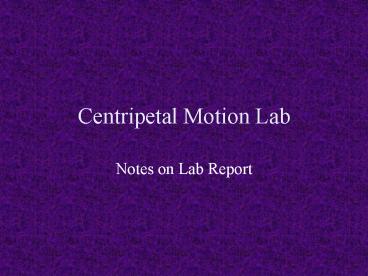Centripetal Motion Lab - PowerPoint PPT Presentation
1 / 23
Title:
Centripetal Motion Lab
Description:
To enter your mass, divide the little stopper mass by 1000. For Part 1 and 3 you used 1 stopper only so the mass is the same for all 6 trials ... – PowerPoint PPT presentation
Number of Views:21
Avg rating:3.0/5.0
Title: Centripetal Motion Lab
1
Centripetal Motion Lab
- Notes on Lab Report
2
Outline
- Title Page
- Purpose
- Intro
- Procedure
- Data
- Analysis
- Conclusion
3
Purpose
- To verify the formula for centripetal motion
using experimental values. - F mv2
r
4
Introduction
- The introduction should explain all the ideas
needed to understand the lab, such as - What is centripetal force?
- What is the formula for centripetal force?
- Generally, how are you going to verify the
formula in this lab?
5
Introduction
- What is centripetal force?
- The force that pulls an object in a circular path.
6
Introduction
- What is the formula for centripetal force?
- F mv2/r
- This can be solved for v to make
F centripetal force m mass of object v
velocity r radius of circular motion
7
Introduction
- Generally, how are you going to verify the
formula in this lab? - This equation can be tested by changing the F, r,
and m and seeing if the effects on v make sense.
8
Introduction
- Generally, how are you going to verify the
formula in this lab? - For example, the F is on top of the fraction so
if F increases so does V. So by increasing the
centripetal force on the object, the velocity can
be measured to see if it also increases. If it
does, then the data supports the equation.
9
Introduction
If the data matches the trends described, then
the data supports the equation.
10
Introduction
Graphs can also help support the formula. Since
there is a square root in the formula, , the
graphs will be curved. The graphs should look
like the following
v
v F r
m
v
m
11
Introduction
- Finally, the formula should verify the force used
in all three parts of the lab.
12
Introduction
- The force from the lab should equal the force
from the formula, F mv2/r
13
Introduction
- The closer these values are, the better the lab
supports the formula.
14
Procedure
- Copy the steps of the lab
- Write this section in steps
- Download the directions from the website
- Cut and paste them into your report
15
Data and Analysis
- Open the Lab Report Excel Spreadsheet file from
the website - Fill in your data for the mass, force, radius,
and time - The spreadsheet will automatically create your
velocity, acceleration and force values. - Your graphs will form in separate tabs at the
bottom of the spreadsheet.
16
Data and Analysis
- To enter your mass, divide the little stopper
mass by 1000. - For Part 1 and 3 you used 1 stopper only so the
mass is the same for all 6 trials - For Part 2, multiply the of stoppers by the mass
of 1 stopper to get the mass for each trial.
17
Data and Analysis
- To enter the Force values, divide the large
stopper mass by 1000 and then multiply by 9.81. - In Part 1 enter the stoppers times the mass of
one stopper for each trial - In Parts 2 and 3, you used 3 stoppers for the
whole table so multiply the mass of one stopper
by 3 and enter that in all of the cells.
18
Data and Analysis
- To enter radius values, for Parts 1 and 2 just
enter the radius in meters, .2000m - For Part 3, you have your own radius data. Just
make sure you enter it in meters by dividing the
cm values by 100.
19
Data and Analysis
- When you are done your data table will
automatically make graphs - You need to open the tabs at the bottom of the
page - Right click on any point
- Select Add Trendline
20
Data and Analysis
- Once in the trendline, select the Exponential
graph - Then select Options
- Select Show Equation
- Hit finish
- Repeat for all 3 graphs
- Print out the entire workbook
21
Conclusions
- The conclusion sums up the lab by describing how
well the purpose was accomplished - In a paragraph, explain how well the data and
analysis support the equation F mv2/r.
22
Conclusions
- Did the values of the F, m and r cause the
predicted changes in v? - Did the graphs look like they were supposed to?
- Did the values of the Forcecolumn
Fmacolumn?
23
Report
- Due next Thursday, Jan. 25th
- Typed
- Individually completed
- Data and analysis can be shared
- Introductions and conclusions must be unique no
copying allowed




























